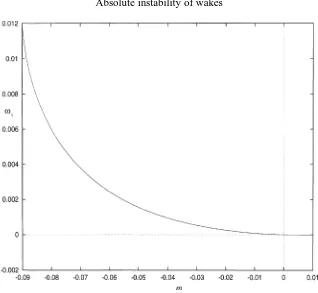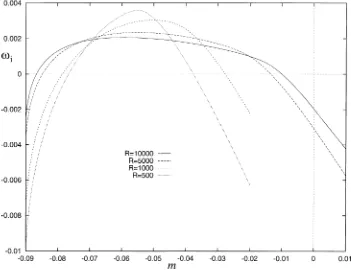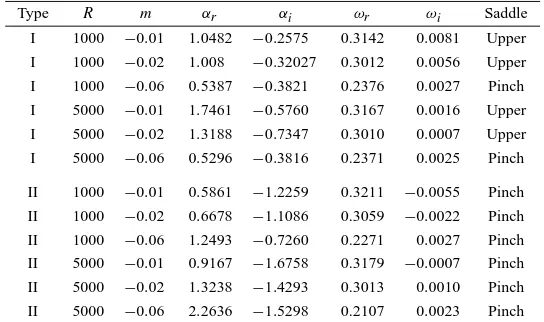A note on the absolute instability of wakes
M.J. Taylor, N. Peake *
Department of Applied Mathematics and Theoretical Physics, Silver Street, Cambridge CB3 9EW, UK
(Received 29 June 1998; revised and accepted 11 December 1998)
Abstract – The family of wake profiles formed from the Falkner–Skan boundary-layer solutions with negative pressure gradient,m, was shown in (Woodley and Peake, 1997) to be inviscidly absolutely unstable. However, due to numerical difficulties, the limitm→0 was not considered there, although the results that were found appeared to indicate that the double Blasius profile (m=0) is absolutely unstable. In this note we repeat those calculations using an alternative formulation, and show that in fact the absolute instability present form <0 becomes neutral asm→0, so that the flat-plate wake is only convectively, and not absolutely, unstable. In addition, the effects of viscosity are included here using the Orr–Sommerfeld equation, and two sets of saddle points are now found, one set corresponding to the inviscid family, which can be either pinching or non-pinching depending on the values ofmand the Reynolds number, and another set which is always pinching, but which is stable formclose to zero.Elsevier, Paris absolute instability / wakes
1. Introduction
Woodley and Peake [1] examined the inviscid linear stability properties of the symmetric wake flow near the trailing edge of a thin aerofoil at zero incidence. The flow at the trailing edge was represented using both genuine profiles obtained by integrating the boundary layer equations, and by the Falkner–Skan boundary-layer solutions with negative pressure gradient, m. The profiles at the trailing edge were used as initial conditions for the wake evolution downstream, and a key issue for the stability of the wake as a whole was seen to be the stability of this initial trailing-edge profile. For the profile formed from the Falkner–Skan solution, absolute instability was found for allm less than about −0.01, but difficulties with the numerical solution prevented the behaviour for largerm, and in particular for the double-Blasius wake profile (m=0), from being studied. However, the results that were found did indicate that the Blasius wake might well be absolutely unstable (see figure 6 of Woodley and Peake [1]). In this note we repeat the analysis of Woodley and Peake [1] using, in the first instance, an alternate formulation of the stability problem, and show that this impression is incorrect, and that the flat-plate wake is absolutely stable. Moreover, the inviscid analysis is extended here to include viscosity using the Orr–Sommerfeld equation, from which it becomes clear that the stability characteristics of the model wake change significantly with varying Reynolds number and pressure gradient.
The study of the causal response of shear-layer flows to impulsive forcing is based on the work of Briggs [2] and Bers [3] in plasma physics, who demonstrated that an absolute instability arises when two (or more) spatial modes originating in opposite half planes pinch together as the temporal contour is lowered towards the real axis. This pinch corresponds to an unstable mode with zero group velocity, and hence to disturbances which grow in time at a fixed point in space and potentially lead to nonlinear behaviour. Considerable attention has already been paid to analysing models of bluff-body wake flows in this way, for instance by Betchov
Aggarwal [6] studied the viscous absolute instability of the Gaussian wake profile. A full review of this work is given in Huerre and Monkewitz [7]. However, it seems that prior to Woodley and Peake [1] rather less attention had been paid to profiles which might resemble the wake of a thin body, although we note that Papageorgiou and Smith [8] have examined in detail the stability of the flat-plate wake, but not from the point-of-view of possible absolute instability.
2. Inviscid problem
We consider steady parallel flow in the x direction, with speed f′(|y|) (i.e. symmetric about y =0), where f (y) is the usual attached-flow Falkner–Skan solution with negative pressure gradient m, with −0.0904< m60 (see e.g. Schlichting [9]). The inviscid stability of this flow is described by the Rayleigh equation, which can be written in terms of they unsteady velocity perturbationv(y)ˆ exp(−iωt+iαx)in the form
Here, velocities have been nondimensionalised with respect to the freestream speed and lengths with respect to the boundary layer thickness. The alternative form of (1), in terms of the unsteady pressurep(y)ˆ exp(−iωt+
iαx), was used by Woodley and Peake [1]. Together with (1) we have the boundary condition of decaying solutions at infinity,vˆ→0 as|y| → ∞, and we seek sinuous, antisymmetric modes, in common with much of the previous analysis of related problems (it seems that the varicose modes are not prone to absolute instability). In some previous work (such as Hultgren and Aggarwal [6]), sinuous modes have been selected by setting
ˆ
these two conditions are only equivalent when the steady centreline shear, f′′(0), is zero (which is the case for the Gaussian wake studied by Hultgren and Aggarwal [6]). However, we find that in our problem setting
ˆ
p(0)=0 produces absolute instability over a wider range ofmthan setting vˆ′(0)=0, and moreover ensures that the pressure remains continuous acrossy=0.
The eigenvalue problem described above was solved using a fourth-order Runge–Kutta integrator in the
y direction, shooting from y = ∞ (where the simple uniform-flow solution can be applied) to satisfy the boundary condition on y=0, and saddle points of zero group velocity identified using a Newton–Raphson search procedure. Only saddle points formed by modes pinching from opposite halves of the α plane lead to absolute instability, but this can easily be checked by tracking the modes away from the saddle as ωi is
Figure 1. Temporal growth rate of the absolute instability against Falkner–Skan pressure gradient parameterm.
once again with thepˆ formulation, and have obtained identical results to those shown here. It should be noted, however, that the way in which the inflexion point moves inward towards the centreline asmincreases means that significantly many moreyintegration points are required in the latter case before the solution agrees with that shown in figure 1—fewer integration points lead to the behaviour reported by Woodley and Peake [1]. This confirms that the increase in growth rate formgreater than about−0.02 seen in Woodley and Peake [1] figure 6 is erroneous.
3. Viscous problem
The stability problem for a strictly parallel, viscous two-dimensional flow is described by the Orr– Sommerfeld equation
∂2
∂y2−α 2
2 ˆ
v=iR
(αU−ω)
∂2
∂y2 −α
2−αf′′′v,ˆ (3)
whereR is the Reynolds number. The numerical solution of this equation is completed by expressing it as a set of four first-order equations invˆ and its derivatives, and full details are given in Mack [10]. We again have zero disturbance at infinity, and look for antisymmetric modes by now applying the two conditions
ˆ
p(0)= ˆp′′(0)=0. Sincef′(0)=0 for the Falkner–Skan profiles, it is straightforward to show that
∂2pˆ
∂y2 −α 2ˆ
Figure 2. The growth rates for the Falkner–Skan wake at type I saddles at a range of Reynolds numbers. TheR= ∞case was calculated using Eq. (1).
Table I. Table of saddle points for a range ofmandR. eigenvalue problem is then completely specified, and can be solved as before, but this time with Gram–Schmidt orthonormalisation to control parasitic error growth.
For the viscous problem we find two families of saddle points. In figure 2 the growth rates for one family (which we will refer to as type I) are plotted againstmfor a range of Reynolds numbersR. We can see that the viscous results approach the inviscid result as R is increased, so that the type I saddles correspond to the inviscid family of the previous section. Also in figure 2 we can see that the growth rate increases with decreasing Reynolds number, suggesting that the Blasius wake becomes increasingly absolutely unstable for decreasingR. However, this result is misleading, since it turns out that the type I saddles change from pinching to non-pinching, and therefore no longer lead to absolute instability, formabove a certain critical value for eachR. This is due to their interaction with a second family of saddles (type II), which are always pinching and which have no counterpart in the inviscid case. The temporal growth rates of the type II saddles are plotted in figure 3 for a range of Reynolds numbers, and for a givenR they are seen to be stable for bothmsufficiently close to zero and formsufficiently large and negative. For definiteness, some specific numerical results for the two sets of saddles are given in table I, where the type of saddle is also indicated; ‘Upper’ means that the saddle is formed from two modes coalescing from the upper half of the spatial plane, and is therefore not an absolute instability, while ‘Pinch’ indicates modes coalescing from opposite half planes, leading to absolute instability.
In figures 4 and 5 the contours of constant ωr,i are plotted for two different values ofR atm= −0.06 and m= −0.02 respectively. In each case the type I saddle lies above the type II saddle. In figure 4 both saddles are pinching, and from table I it is clear that they have comparable temporal growth rates for both values ofR. ForR=5000 the growth rate is also comparable to the inviscid case (figure 3), presumably because the type II saddle is sufficiently far from the type I saddle to have little effect on it, but forR=1000 the saddles move closer together, leading to a growth rate which is (slightly) larger than the inviscid result. In figure 5 the type II saddle has now passed underneath the type I saddle, and this has the effect of transforming the nature of the type I saddle from being a genuine pinch to being merely a coalescence between two modes originating in the upper half plane. This can be seen by noting the directions of increasing ωi; form= −0.02 the movement
(a) (b)
Figure 4. Contours of constantωr (dotted lines) and constantωi (solid lines) form= −0.06 with (a)R=1000 and (b)R=5000. Two pinch
points, leading to absolute instabilities, are present in each case. The contour values are 0.216ωr60.24, in equal increments of 0.005, and 0.0016ωi60.003, in equal of increments 0.0005.
(a) (b)
Figure 5. Contours of constantωr(dotted lines) and constantωi(solid lines) form= −0.02 with (a)R=1000 and (b)R=5000. In both cases the
lower saddle point leads to an absolute instability, but the upper one corresponds to the pinching of two modes originating in the upper half plane. In (a) the contour values are 0.2956ωr60.309, in equal increments of 0.002, and−0.0036ωi60.007, again in equal of increments 0.002. In (b) the
additional contoursωr=0.3011,0.3013,0.3015,ωi=0.0006 have been introduced for clarity.
interaction between the 2 families of saddles changes the character of the wake response, and in particular prevents the type I saddle leading to absolute instability formsufficiently close to zero.
4. Conclusion
In summary, even a relatively simple wake profile can possess quite complicated stability properties, and in this case we have seen that either two, one or zero absolutely unstable pinch points can be present, depending on the values of the pressure gradient and Reynolds number.
References
[1] Woodley B., Peake N., Global linear stability analysis of thin aerofoil wakes, J. Fluid Mech. 339 (1997) 239–260. [2] Briggs R., Electron-Stream Interaction with Plasmas, MIT Press, 1964.
[3] Bers A., Linear waves and instabilities, in: DeWitt C., Peyraud J. (Eds), Physique des Plasmas, Gordon and Breach, 1975, pp. 113–215. [4] Betchov R., Criminale W., Spatial instability of the inviscid jet and wake, Phys. Fluids 9 (1966) 359–362.
[5] Koch W., Local instability characteristics and frequency determination of self-excited wake flows, J. Sound Vib. 99 (1985) 53–83. [6] Hultgren L., Aggarwal A., Absolute instability of the Gaussian wake profile, Phys. Fluids 30 (1987) 3383–3387.
[7] Huerre P., Monkewitz P., Local and global instabilities in spatially developing flows, Ann. Rev. Fluid Mech. 22 (1990) 473–537.
[8] Papageorgiou D., Smith F.T., Linear instability of the wake behind a flat plate placed parallel to a uniform stream, J. Fluid Mech. 208 (1989) 67–89.
[9] Schlichting H., Boundary Layer Theory (7th ed.), McGraw-Hill, 1979.
[10] Mack L., Special course on stability and transition of laminar flow, AGARD Report 709, NATO, 1984. [11] Koch W., Direct resonance in Orr–Sommerfeld problems, Acta Mech. 58 (1986) 11–29.



